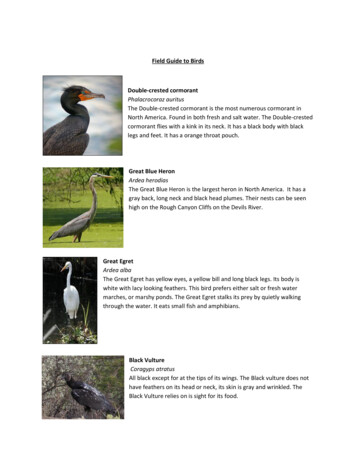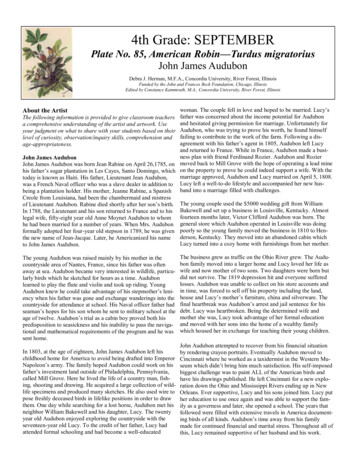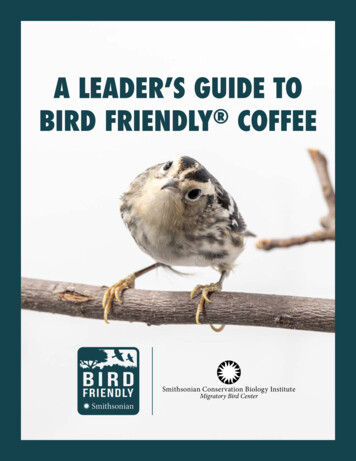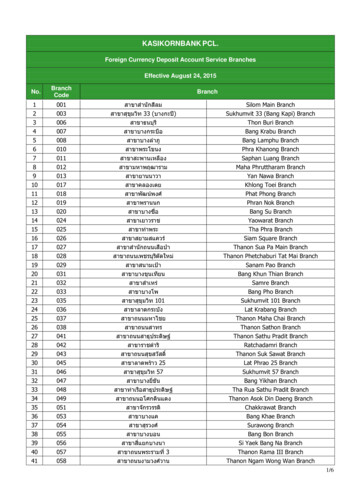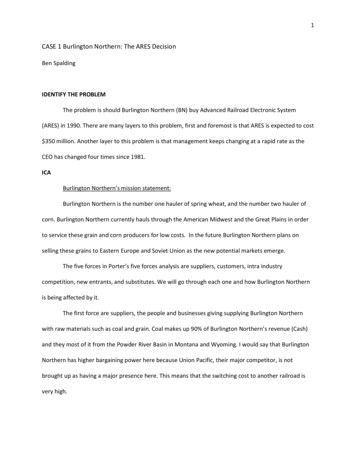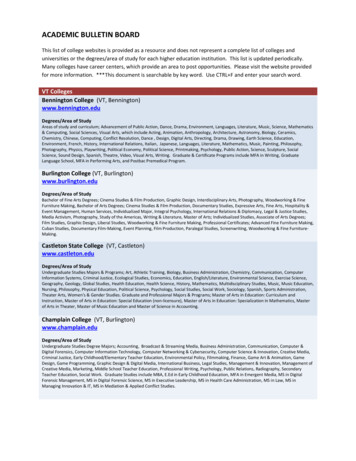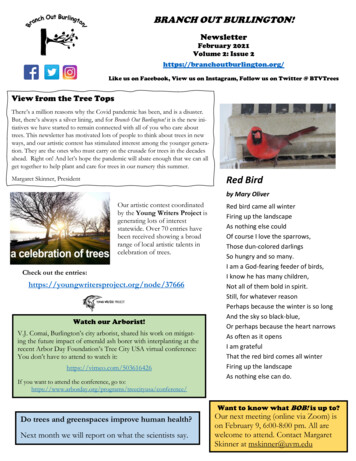
Transcription
BRANCH OUT BURLINGTON!NewsletterFebruary 2021Volume 2: Issue 2https://branchoutburlington.org/Like us on Facebook, View us on Instagram, Follow us on Twitter @ BTVTreesView from the Tree TopsThere’s a million reasons why the Covid pandemic has been, and is a disaster.But, there’s always a silver lining, and for Branch Out Burlington! it is the new initiatives we have started to remain connected with all of you who care abouttrees. This newsletter has motivated lots of people to think about trees in newways, and our artistic contest has stimulated interest among the younger generation. They are the ones who must carry on the crusade for trees in the decadesahead. Right on! And let’s hope the pandemic will abate enough that we can allget together to help plant and care for trees in our nursery this summer.Margaret Skinner, PresidentRed Birdby Mary OliverOur artistic contest coordinatedby the Young Writers Project isgenerating lots of intereststatewide. Over 70 entries havebeen received showing a broadrange of local artistic talents incelebration of trees.Check out the Watch our Arborist!V.J. Comai, Burlington’s city arborist, shared his work on mitigating the future impact of emerald ash borer with interplanting at therecent Arbor Day Foundation’s Tree City USA virtual conference:You don’t have to attend to watch it:https://vimeo.com/503616426If you want to attend the conference, go onference/Red bird came all winterFiring up the landscapeAs nothing else couldOf course I love the sparrows,Those dun-colored darlingsSo hungry and so many.I am a God-fearing feeder of birds,I know he has many children,Not all of them bold in spirit.Still, for whatever reasonPerhaps because the winter is so longAnd the sky so black-blue,Or perhaps because the heart narrowsAs often as it opensI am gratefulThat the red bird comes all winterFiring up the landscapeAs nothing else can do.Want to know what BOB! is up to?Do trees and greenspaces improve human health?Next month we will report on what the scientists say.Our next meeting (online via Zoom) ison February 9, 6:00-8:00 pm. All arewelcome to attend. Contact MargaretSkinner at mskinner@uvm.edu
Who’s Minding our Trees?A Tribute to ourGood Friend,Bob PeischBob Peisch, a long time BOB! volunteer passed away in June2020 of complications from Parkinson’s and heart disease. Hewas born and raised on Apple Tree Point in Burlington (VT).Most of us came to know Bob through our annual tree sale – hepurchased trees each year, and his was always one of the first orders received. Every year Bob helped with the Dip and Bag session for our tree sale, when we prepared the trees for customerpick up. Every year he worked tirelessly on tree planting day atthe Community Tree Nursery. When he wasn’t tending toBOB!’s trees, he was a faithful volunteer firefighter for Ferrisburgh.We all have colorful “Bob” stories, though not all are fit to print!A few years back, Bob came to help, and his hands were badlyinflamed due to a fire-fighting accident. The BOB! team leaderasked, “Don’t your hands hurt?” Without skipping a beat, Bobreplied, “They’re killing me” and went right back to work! Heplanted a row of beautiful maples along his driveway, purchasedfrom our tree sale over the years. He called them his legacy. Tothe very end he was still planning for the next tree he wouldplant. Just a few weeks before he passed away, he contacted thetree sale coordinator and asked “Any chance a Magnolia fell offof the truck I can buy?”. Conversations with Bob after weedingbees were classic. No one can never forget when he talked aboutattending the original concert in Woodstock Bob was one of a kind. Every tree and shrub he received fromBOB! was special to him. Whenever you visited his home, hetook time to point out each one, including a lilac he won forhelping at the nursery tree planting. He never wanted to supervise the work, though he knew exactly what needed to be done.He preferred to be what he called a “mule”. He told us about thetime he pulled into his yard and found a group of neighbor kidsstanding on his porch eating peaches off his tree, juice just running all down their faces. He just loved it!Bob will be sorely missed. May he rest in peace, knowing he hasleft a wonderful living legacy in his yard and throughout Chittenden County. Bob left BOB! funds in his will to carry on ourwork in his absence. Plans are underway to honor his physicaland monetary contributions to Burlington’s trees with a specialtree planting ceremony.Derrek Eckhardt is!Over the summer you might seethe tree crew working hard onplanting, pruning or wateringour street trees. One of them isDerrek, an arborist technicianfor the Burlington Dept. Parks,Recreation and Waterfront. Hegrew up down south in Shaftsbury (VT) and attended Mt. Anthony Union High School. Hegraduated from UVM in 2010with a BS from the Plant & SoilScience. From 2008 to 2015 heworked as a summer seasonalemployee for Burlington Parks.He spread his wings after college but, like so many UVMgrads, was drawn back to Burlington, and was hired full timefor the Parks Dept. in 2016, working on the tree inventory.Thanks to him and the inventory we know what tree isplanted where and when throughout the streets of Burlington. It also tracks when trees need pruning or fertilizing. Theinventory gives the location of all ash trees which allows Derrek and the rest of the Tree Crew to look out for signs of theemerald ash borer. When he isn’t up a tree pruning deadbranches, he is planting and caring for flower beds aroundthe parks. Over the past two years he was instrumental in designing and converting all of the flower beds in the parksfrom annuals to perennials. This reduces the cost of annualreplanting and maintenance. He also played a key role in thelayout and planting of the newly renovated City Hall Park.He lives north of Burlington with his partner, Caitlyn and hisdog Piper. When he isn’t tending to our trees, he enjoys gardening, back country skiing, and experimenting with makingnew flavors of hard cider.The bottom line is Derrek is a lifeline to Burlington’s streetand park trees. The next time you see him up a tree, give hima friendly wave or say “THANKS!”Derrek getting his handsdirty, while planting atree at Apple Tree Point.He will return severaltimes over the summer tofill the green gator bagwith water to keep thetree hydrated.
What does it Take to Save a Tree?V.J. Comai, Burlington City ArboristRenovation of City Hall Park in the heart of downtown is finally complete. At the center of the park redesign debate wasthe fate of the park’s 51 existing mature trees, which supplieda place of cool respite within our hot cityscape. Initial planscalled for removal of many of them to accommodate widerpaths and a fountain and building storm water mitigation features. Some were past their prime and structurally unsound.They had to go. Others were healthy enough, but were in conflict with proposed infrastructure specified in the new design.I was charged with assessing the health of each tree to retainas many existing trees as possible, without compromising thegoals of the redesign plan. Several of the trees were in verybad shape which had resulted from compromising root issuesdue in part to severely compacted soils. I worked with the designer and City team to revise the plan so several existing mature trees could be saved, including some large floweringcrabapples in front of City Hall and a very large silver maplealong Saint Paul St. This tree was slated for removal because itwas inside the proposed raingarden, a large basin to capturestorm water.As I studied the plans, I realized there might be a way to keepthis tree if the raingarden was shifted and re-engineered tolimit adverse impacts to the tree roots. Even with thosechanges, roots on one side of the tree were damaged duringexcavation, and the tree needed some special attention to survive.First, we pruned the roots, making fresh surgical cutson all damaged roots. All of this occurred during thedrought so we had to keep the tree well-watered. Afterthe final grading around the park was complete, weperformed a root invigoration procedure within thecritical root zone of the tree to further reduce adverseconstruction impacts and promote new root growth.This involved using an air spade, a specialized nozzleattached to a compressor that loosens soil within thecritical root zone with high pressure air. The soil wasaerated to a depth of 8-10 inches all around the tree toa distance of 10 feet from the trunk. Compost, biochar, and a slow release organic granular fertilizer wereadded and incorporated into the soil to increase fertility and promote new root growth. The tree was watered by hand frequently throughout this period untilthe permanent irrigation system was operating.At first the tree crown appeared thin after all this disruption, clearly showing signs of stress. However, asthe summer progressed, I noticed new healthy darkgreen leaves developing. Now I am confident the treewill make a strong recovery thanks to our tender loving care. This goes to show that it takes special attention to save an individual tree, and as our green spacesshrink, saving mature trees matter. In future articles Iwill describe other innovations installed within thepark to ensure the new and old trees thrive and provide shade for years to come.Silver maple after aeration ofthe soil with an air spade. Fertilizer and biochar were spreadaround the tree to increase fertility and stimulate growth.Raingarden planted withperennials around the silver maple we rejuvenated.
Profiles of Courage & BeautyMaggie Citarella prepared descriptions of a couple of tree species we grow in our community treenursery that will be transplanted out on our streets in the coming years. Tom Roland described anunusual tree in our Burlington landscape. Check it out.Japanese ZelkovaScientific name: Zelkova serrata – Green VaseJapanese zelkova is a large, fast-growing, deciduous treewith a spreading, vase-shaped crown, that fills a gap left bythe American elm. It typically grows 60-80 ft tall and 40-50ft wide. Small green flowers bloom in early spring as leavesemerge. Its scientific name is partly chosen for the tree’sserrated leaves (i.e., serrata). Fruits are non-descript,brown drupes that emerge in summer to fall. The leaves areshiny green in summer and provide showy red to coppercolor in the fall. This tree is known for its attractive, exfoliating bark. Zelkova is native to Japan, Taiwan, and easternChina, and is somewhat resistant to Dutch Elm Disease. It istolerant to drought and other harsh urban conditions.Zelkova is a great lawn, shade, or street tree. It needs fullsun. In Burlington, sun scald has been observed, and it doesnot appear to be particularly long-lived in our region. It typically grows in plant hardiness zones 5-8. Burlington maybe at the edge of its range, which may explain it doesn’tthrive here. The Parks department has cut back on plantingthis tree, though it is a beauty.Additional Information: /PlantFinderComments.aspx?kempercode aseGive a Lasting MemoryWant to honor a loved one for their contributions, or leave a living legacy in memory of a friend or family member?Instead of flowers, give a tree through our Give-A-Tree program? For 130 you can contribute to planting of a tree in Burlington, to make it a greener city. The donation is used to purchase and care for a tree in our community tree nursery. The tree isplanted in its final home along a Burlington street or in one of our parks. To learn more, go to: Give-a-Tree Program - BranchOut Burlington! or contact Margaret Skinner, mskinner@uvm.edu; 802-656-5440.
Red MapleScientific name: Acer rubrumRed maple trees are medium-sized, deciduous trees native to easternNorth America. Amazingly, red maples have the greatest north–southgeographic range of any tree species living entirely in the Eastern forests. They typically grow at a moderate to fast rate, reaching 40-60 fttall and 30-50 ft wide with a rounded, oval crown. The largest redmaple in the US lives in Great Smoky Mountains National Park and is141 ft tall! These trees typically grow in wet bottomland, river floodplains, and wet woods. The specific epithet, rubrum, means red andrefers to the red flowers in dense clusters in spring before leaves appear, red fruit (initially red, two-winged samara), red stems, twigs,and buds, and excellent orange-red fall color. The fruit, leaves, andshoots provide important food for wildlife. It is tolerant of wet soiland air pollution. Red maples are excellent for the lawn, on streets, inrain gardens or parks. They have a shallow, flattened root system thatmay buckle nearby sidewalks or driveways, so be careful when planting near pavement. They grow best in full sun but tolerate partialshade. They grow in plant hardiness zones 3-9.Additional Information: /PlantFinderDetails.aspx?kempercode etail.cfm?itemID 867Branch Out Burlington! is a prouddonor to Feeding Chittenden. Webelieve in caring about peoplewhile we care for trees.Do you know a school or public space that needsa tree to make their space more beautiful?Every year, BOB! gives away trees to local schools,towns and non-profits with space for one. ContactSteve Rivard at reevesovnt@aol.com to apply.You can still get tree gators to water your trees and mugs to drink instyle.Order online: /14thannual-tree-sale/All funds support our tree planting inBurlington and beyond and for trees forVT non-profits.This slow release watering system delivers 20gall. directly to tree roots with no run-off orevaporation. It saves time, money, and water,and efficiently waters your tree.
Fernleaf European BeechTom Roland describes an unusual tree in our landscape. Check it out.Scientific name: Fagus sylvatica ‘Asplenifolia’This past fall, while sitting outside the “Great Harvest Bread Company” on Pine St.,Burlington (VT), I noticed a striking tree which I had missed before. Previously,tasty cinnamon rolls or free bread slices held my focus more than this beautiful 30foot specimen in our urban landscape. There was something different about thistree. The smooth grey, almost silver, bark looked familiar, but the leaves just didn’tmatch anything I knew. They were more delicate, somewhat pointed, and lacy in thewarm breeze.Because of Covid restrictions, I approached for a closer look cautiously as two fellowcinnamon-roll devotees occupied a bench near the tree. From a safe distance mycell phone honed in on the leaves for a close photo, and for later research. To mysurprise the couple announced, “Oh that’s a fernleaf European Beech. We just identified it with our cell phone.” There’s an app for that. There are several tree id appsfor smart phones, like PlantNet (https://identify.plantnet.org/), LeafSnap(https://plantidentifier.info/) and iNaturalist (https://www.inaturalist.org/).Native to central and southern Europe, and more commonly found in zones 5-7, F.sylvatica ‘Asplenifolia’ can grow in plant hardiness zone 4, minimum -20 F. Potentially reaching 80 feet or more, this “Great Harvest” specimen was clearly an adolescent. The long, slender, deeply lobed leaves are reminiscent of fern fronds, thus thecommon name, fernleaf beech. Oval form and low branches are characteristic andmake it an uncommon and pleasing choice for landscaping. The “give-away” foridentification rests in the smooth, light grey bark characteristic of all beech trees.Once established this tree has average water needs, but does not like heavy, poorlydrained soils. While not the easiest tree to transplant, requiring careful watering atfirst, it will contribute years of beauty to the landscape. Receiving the Award of Garden Merit by the Royal Horticultural Society, this gives cooling shade and bird habitat. And, a wonderful companion to sit with while enjoying a cinnamon roll.Additional Information: antfinder/fagus sylvatica asplenifolia--fernleaf beechPersonal Experiences with the Lanternfly from Greg Epler-Wood This dreaded invasive pesthitchhiked to Berks County, PA in 2014, on pallets of rocks from China. I was born and raised in Reading, justoutside the Berks’ county seat. By 2015, it had already spread over 20 miles. My wife and I drove there to seemy Mom, and she was zapping the flashy adults with a spray bottle of dilute Dawn liquid soap. They were everywhere – on bushes, furniture and walking around her patio.On a visit in Spring, 2016, we drove to the local market for plants. It was then I discovered why these guys are called “hoppers.”While Mom browsed for plants, I busily tried to kill the buggers. The adults can’t fly far, but boy, the newly hatched nymphs surecan speed away in all directions. With luck, if you spot where it lands and you are fast, you might squish one of them. Mom andother shoppers had learned to ignore them at this life stage because, I suppose, they did not want to look like me—the swatting andstomping outsider who thinks he can make a difference, despite their abundance.In the early days, it was thought it would only attack its favored plant, tree of heaven. Ironically, this tree is also an invasive fromAsia, and some hoped the lanternfly could help eradicate that exotic and then die off when its food ran out? No such luck. Expertssoon realized it has a wide host range, including stone fruit trees, grapes, apples, black walnut, maples and 70 other plants. It hasn’tbeen found in Vermont yet, but it is very possible it will get here. State personnel and the public are keeping an eye out, just in case.The BOB! Mission: We are a group of volunteers who help plant and care for Burlington’s trees. Our goal is to promote a city graced witha variety of beautiful, healthy trees, and a citizenry involved with forever expanding and preserving our urban forest.Produced by: The Volunteers of Branch Out Burlington!with support from our friends in the Burlington Dept. of Parks, Recreation & WaterfrontCopyright 2021 Branch Out Burlington!
Derrek, an arborist technician for the Burlington Dept. Parks, Recreation and Waterfront. He grew up down south in Shafts-bury (VT) and attended Mt. An-thony Union High School. He graduated from UVM in 2010 with a BS from the Plant & Soil Science. From 2008 to 2015 he worked as a summer seasonal employee for Burlington Parks. Who's Minding .
